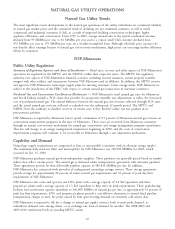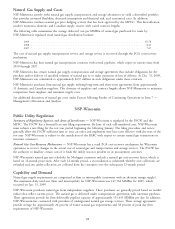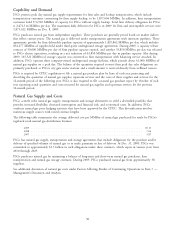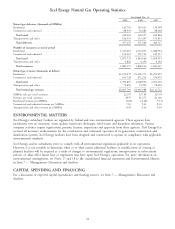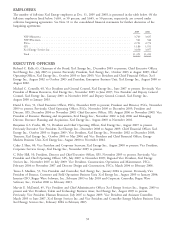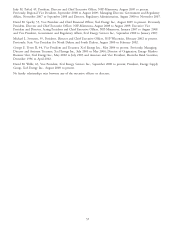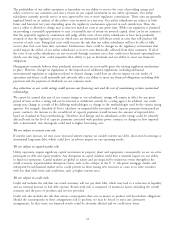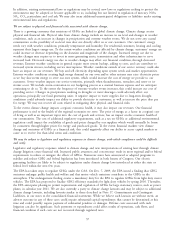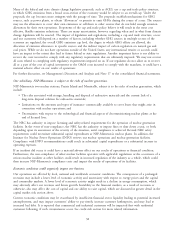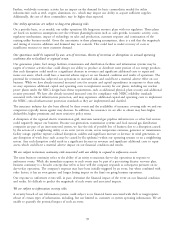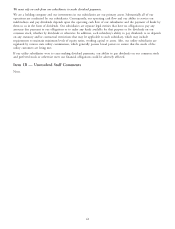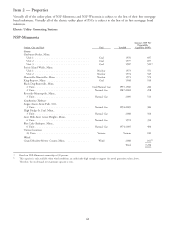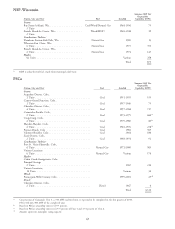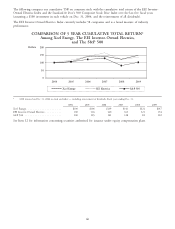Xcel Energy 2009 Annual Report Download - page 46
Download and view the complete annual report
Please find page 46 of the 2009 Xcel Energy annual report below. You can navigate through the pages in the report by either clicking on the pages listed below, or by using the keyword search tool below to find specific information within the annual report.One alternative available to address counterparty credit risk is to transact on liquid commodity exchanges. The credit
risk is then socialized through the exchange central clearinghouse function. While exchanges do remove counterparty
credit risk, all participants are subject to margin requirements, which create an additional need for liquidity to post
margin as exchange positions change value daily. Additional margin requirements could impact our liquidity.
We may at times have direct credit exposure in our short-term wholesale and commodity trading activity to various
financial institutions trading for their own accounts or issuing collateral support on behalf of other counterparties. We
may also have some indirect credit exposure due to participation in organized markets such as the PJM Interconnection
and MISO in which any credit losses are socialized to all market participants.
We do have additional indirect credit exposures to various financial institutions in the form of letters of credit provided
as security by power suppliers under various long-term physical purchased power contracts. If any of the credit ratings
of the letter of credit issuers were to drop below the designated investment grade rating stipulated in the underlying
long-term purchased power contracts, the supplier would need to replace that security with an acceptable substitute. If
the security were not replaced, the party would be in technical default under the contract, which would enable us to
exercise our contractual rights.
We are subject to commodity risks and other risks associated with energy markets and energy production.
We engage in wholesale sales and purchases of electric capacity, energy and energy-related products and are subject to
market supply and commodity price risk. Commodity price changes can affect the value of our commodity trading
derivatives. We mark certain derivatives to estimated fair market value on a daily basis (mark-to-market accounting),
which may cause earnings volatility. Actual settlements can vary significantly from these estimates, and significant
changes from the assumptions underlying our fair value estimates could cause significant earnings variability.
If we encounter market supply shortages, we may be unable to fulfill contractual obligations to our retail, wholesale and
other customers at previously authorized or anticipated costs. Any such supply shortages could cause us to seek
alternative supply services at potentially higher costs or suffer increased liability for unfulfilled contractual obligations.
Any significantly higher energy or fuel costs relative to corresponding sales commitments would have a negative impact
on our cash flows and could potentially result in economic losses. Potential market supply shortages may not be fully
resolved through alternative supply sources and such interruptions may cause short-term disruptions in our ability to
provide electric and/or natural gas services to our customers. The impact of these cost and reliability issues vary in
magnitude for each operating subsidiary depending upon unique operating conditions such as generation fuels mix,
availability of water for cooling, availability of fuel transportation, electric generation capacity, transmission, etc.
We are subject to environmental laws and regulations, with which compliance could be difficult and costly.
We are subject to environmental laws and regulations that affect many aspects of our past, present and future
operations, including air emissions, water quality, wastewater discharges and the generation, transport and disposal of
solid wastes and hazardous substances. These laws and regulations require us to obtain and comply with a wide variety
of environmental registrations, licenses, permits, inspections and other approvals. Environmental laws and regulations
can also require us to restrict or limit the output of certain facilities or the use of certain fuels, to install pollution
control equipment at our facilities, clean up spills and correct environmental hazards and other contamination. Both
public officials and private individuals may seek to enforce the applicable environmental laws and regulations against us.
We may be required to pay all or a portion of the cost to remediate (i.e. clean-up) sites where our past activities, or the
activities of certain other parties, caused environmental contamination. At Dec. 31, 2009, these sites included:
• Sites of former MGPs operated by our subsidiaries, predecessors, or other entities; and
• Third party sites, such as landfills, for which we are alleged to be a potentially responsible party that sent
hazardous materials and wastes.
We are also subject to mandates to provide customers with clean energy, renewable energy and energy conservation
offerings. These mandates are designed in part to mitigate the potential environmental impacts of utility operations.
Failure to meet the requirements of these mandates may result in fines or penalties, which could have a material adverse
effect on our results of operations. If our regulators do not allow us to recover all or a part of the cost of capital
investment or the O&M costs incurred to comply with the mandates, it could have a material adverse effect on our
results of operations.
36



